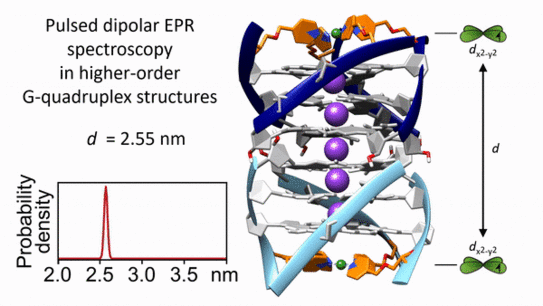Very Precise Distance Measurements in DNA G-Quadruplex Structures
- Research
- Top News
- Press Releases

Human DNA usually adopts a helical, double stranded structure. However, also four-stranded variants (so-called G‑quadruplexes) are known to form from guanine-rich sequences, resembling columnar stacks. In the past years, more and more evidence for biological functions and medicinal relevance of these DNA species was revealed. To understand the role of G‑quadruplexes in the body, their architecture and structure must be elucidated. This is a challenging task, since these special DNA motifs show a high structural diversity. Once spatial structure and biological function are unraveled, small molecules can be specifically designed to bind to these G‑quadruplexes and manipulate their function. Since G‑quadruplexes are thought to play crucial roles in different cancer types and also HIV infection and Malaria, such DNA-binding molecules may show potential application as drugs.
In addition, G‑quadruplexes are known to form higher-ordered structures. For example, they can assemble pairwise and form so-called dimers. Intercalation of small, usually flat molecules into these dimers results in sandwich complexes. It has been difficult to reveal the formation of these nanometer-sized dimers and sandwich structures and even more so to measure their spatial dimension. In close cooperation, the research groups of Jun.-Prof. Müge Kasanmascheff and Prof. Guido Clever at TU Dortmund University have recently been successful in developing a method that allows detecting such structures in solution with unprecedented accuracy.

A strategy including the precise incorporation of copper ions into chemically modified DNA G‑quadruplexes enables distance measurements between unpaired electrons in both halves of the G-quadruplex dimers by a technique called EPR spectroscopy. Small molecules, usually not soluble in water, were intercalated into the dimers in aqueous solution, resulting in a characteristically increased distance between the copper complexes. Due to the tight and rigid binding of the copper ions in the G‑quadruplexes, distances were obtained with remarkable precision.
The project was realized within the RESOLV cluster of excellence funded by the German Research Foundation (DFG) and recently published as an open access paper in the journal Angewandte Chemie. It was selected as a Very Important Paper. The presented method is of particular importance for structure elucidation of DNA G-quadruplex adducts and promises to facilitate the search for novel pharmacologically active molecules.
Contact for further information:





![[Translate to English:] Partner Four hands are holding the green logo of TU Dortmund University](/storages/tu_website/_processed_/1/d/csm_Partner_Nicole_Rechmann_KW_670eba0154.jpg)




![[Translate to English:] Forschung An apparatus with tubes in a laboratory](/storages/tu_website/_processed_/0/c/csm_Forschung_Juergen_Huhn_4fa3153b51.jpg)
![[Translate to English:] Studium Five students are sitting in a lecture hall. They are talking to each other.](/storages/tu_website/_processed_/c/9/csm_Studium_FelixSchmale_dbdbfb0dd7.jpg)





